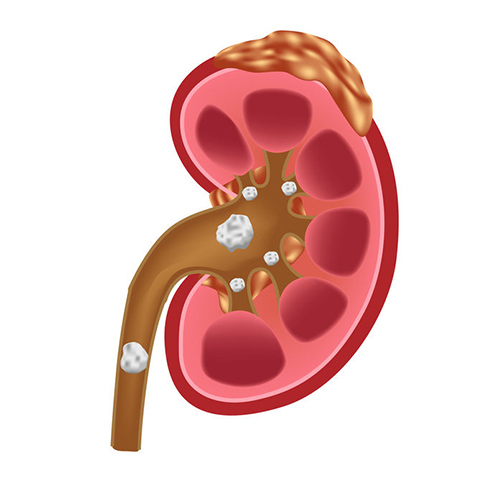Kidney Stones Treatment in St. George, UT
Urology Associates

Kidney stones are one of the most common and painful urological problems. Kidney stones are hard masses or crystals that build up on the inside of your kidneys. They can vary in size from a grain of salt to a golf ball.
Symptoms
Small stones can travel through your urinary system and pass out of your body in your urine without pain. Larger stones usually start to cause pain and other symptoms when they move around in your kidneys or into other parts of your urinary system and begin to block the outflow of urine. Symptoms include:
- Extreme pain in your side and back, below your ribs
- Pain that spreads to your lower abdomen and groin area
- Pain that comes and goes and changes in intensity
- Nausea, vomiting, fever or chills
- Pink, red or brown urine
- Cloudy or bad smelling urine
- Persistent urge to urinate or urinating more than usual
Treatment
Small Stones: If your stone is small, your doctor may recommend you try to pass it out in your urine. To do this, you need to drink a lot of water so that your urine is almost clear. Normally, your doctor will prescribe a pain medication to help with the discomfort and a medication to help your ureters relax to allow the stone to pass.
Large or Complicated Stones: If your stone is too large to pass, blocking the flow of urine or causing other complications, your doctor may recommend one of these treatments.
- Shockwave Lithotripsy: In an outpatient surgery center, your urologist uses a machine called a lithotripter to direct ultrasonic shock waves to hit the stone repeatedly until it crumbles into small particles that you pass in your urine. This is the most frequently used procedure for eliminating kidney stones.
- Ureteroscopy: In this procedure, your urologist passes a flexible tube with a camera through your urethra. A whisk-like basket on the end of the scope snares the stone and removes it. If the stone is too large, the urologist can use a laser inserted through the scope to break the stone apart. After a ureteroscopy, the urologist places a stent in the ureter to hold it open until the swelling subsides. The stent is removed one days later.
- Percutaneous Nephrolithotomy: For large stones that canít be effectively treated with lithotripsy or ureteroscopy, your urologist can perform a minimally-invasive surgery through a 1-centimeter incision in your back. Using a scope and special tools, the urologist can break apart the stone and suction it out.
Comprehensive Urology
Services for Men & Women
Prevention
Once youíve had a kidney stone, you are more likely to have future stones. To minimize your chances of getting additional stones, follow these guidelines.
- Drink water. Water helps keep your urine from becoming too concentrated and forming crystals. A good rule of thumb is to drink enough water to keep your urine a faint yellow color.
- Limit salt. Salt, which is often found in processed foods, can lead to dehydration, causing your urine to become too concentrated.
- Avoid certain foods. For calcium stones, the most common type of kidney stones, avoid foods with high amounts of oxalate including coffee, tea, chocolate, wheat bran, spinach, and strawberries.
We are proud of our commitment to health care and preventive care in St. George, UT! Using only the most current techniques and technologies. At Urology Associates we've grown a reputable practice built on excellence. Schedule an appointment today for more information about our services!

